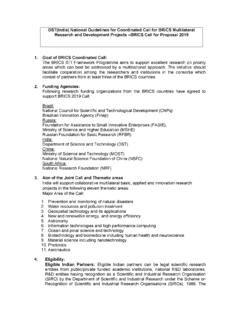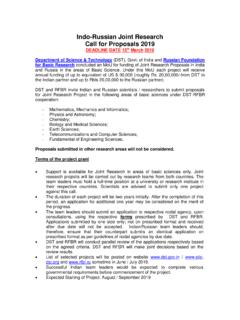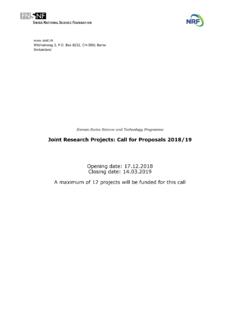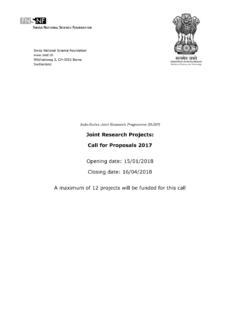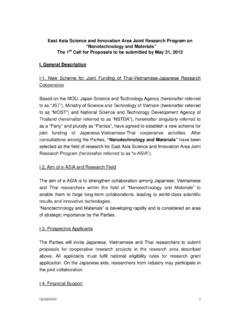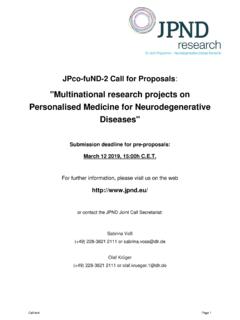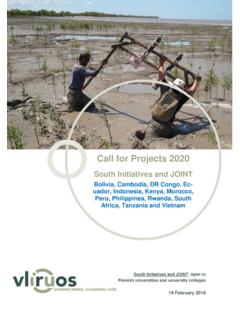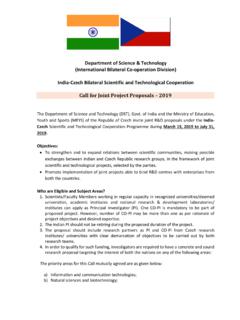Transcription of BRICS STI Framework Programme 3 coordinated call for BRICS ...
1 BRICS STI Framework Programme rd 3 coordinated call for BRICS multilateral projects 2019. call is open until 25th April 2019, 15:00 Moscow Time (UTC+3). (document version ). I. General Description I-1. joint Funding of Multilateral research Cooperation The BRICS STI Framework Programme aims to support excellent research on priority areas which can best be addressed by a multinational approach. The initiative should facilitate cooperation among the researchers and institutions in the consortia which consist of partners from at least three of the BRICS countries. As part of the initiative the following research funding organizations from the BRICS . countries have agreed to jointly establish a new scheme for funding multilateral cooperative activities: Brazil: National Council for Scientific and Technological Development (CNPq).
2 Brazilian Innovation Agency (Finep). Russia: Foundation for Assistance to Small Innovative Enterprises (FASIE). Ministry of Science and Higher Education (MSHE). Russian Foundation for Basic research (RFBR). India: Department of Science and Technology (DST). China: Ministry of Science and Technology (MOST). National Natural Science Foundation of China (NSFC). South Africa: National research Foundation (NRF). 1. I-2. Aim of the joint call and Thematic areas Collaborative multilateral basic, applied and innovation research projects in the following thematic areas can be submitted in response to the call : (a) Prevention and monitoring of natural disasters Human factors such as globalization, population growth, poverty, urbanization and changes in land use are aggravating the adverse consequences of natural hazards.
3 Earthquakes and more frequent and intense extreme weather and climate events are also increasing the risks faced by populations living in vulnerable areas. The losses are increasing in BRICS countries. Repeated exposure to disasters is hampering sustainable development in vulnerable localities. Although we are equipped with increased scientific knowledge and technology, we have not yet been successful in forecasting and effectively coping with unprecedented natural hazards. We need to identify potential risks, evaluate system vulnerabilities, take action from lessons learnt from past experiences and improve emergency preparedness and capacities to manage crises. The present status of international collaboration in disaster risk reduction and management needs to be improved.
4 To reconcile the relationships between development, environmental issues, and improved resilience to disasters, important global decisions were made and came to fruition in 2015, with the Sendai Framework for Disaster Risk Reduction (SFDRR) in March. To end poverty and hunger and make human settlement inclusive, safe, resilient and sustainable, it is essential to strengthen capacity for adaptation to climate change and holistic disaster risk management at all levels. It is first of all important to identify, visualize, and evaluate under-recognized disaster risks that hinder sustainable development by taking a holistic view of the changes in hazards, vulnerabilities and exposures arising from societal and environmental problems.
5 Metrics and indicators should be developed for evaluating vulnerability and resilience. Then, effective measures should be taken to anticipate, prepare for, and reduce the consequent disaster risks. It is equally essential to be able to develop response and recovery countermeasures even in the face of disasters and to build capabilities to make proper decisions for action in a timely manner to protect lives, livelihoods, and communities in order to fully recover from the impact of a disaster. Thus, it is critical to construct societies resilient to disasters by improving understanding of natural and human-made hazards, by developing new technologies for disaster prevention, by constantly raising political and public awareness and by preparing for effective emergency response - 2.
6 Including mental and physical health management - and recovery under the concept of Build Back Better.. To build such resilient societies, scientists and engineers should develop and practice concrete steps to make full use of science and technology with the following two perspectives. The first perspective concerns the promotion of inter-disciplinary research between natural/applied sciences and humanities/social sciences, the former specializing in understanding disaster occurrence mechanisms and design/maintenance of infrastructure and its functions, and the latter in evaluating disaster impact on socio-economic activities and analyzing human perceptions from the viewpoint of behavioral science.
7 The integration of these two domains should be proactively pursued to enhance the disaster reduction capabilities of humankind. The second perspective concerns the promotion of trans-disciplinary cooperation, which enables the social implementation of science and technology for disaster risk reduction, through effective collaboration with Future Earth, to secure sustainable development. Efforts should be made to develop and strengthen a national platform for disaster risk reduction where scientists and practitioners in each country can work closely together with all relevant stakeholders based on discussions on the actual situations faced by their respective countries in their mother tongues The priority (thematic) areas addressed in this call for proposals in the BRICS is as follow: 1.
8 Understanding Disaster Risk. It is critically important to make unflinching efforts for understanding hazards expected to happen and for reducing vulnerability of our infrastructure and society. To make the efforts bear fruit, each country should be supported in Collecting and archiving hazard event records and characterizing them with relevant information on land use and socio-economic activities Producing wide-area hazards and its impact data and information with the utilization of satellite observation and numerical modeling Producing reliable disaster statistics will be conductive to allowing each country to make well-informed decision making for disaster risk reduction. Improving assessment of disaster risks, monitoring and prediction of changes in disaster risks levels, Conducting data integration, analysis and visualization supporting a holistic understanding of disaster processes and consequences.
9 3. 2. Strengthening Disaster Risk Governance to Manage Disaster Risk. in order to Strengthen Disaster Risk Governance, Initiatives should provide support in How society may curb the increase in disaster vulnerability arising from misguided development activities in land use, construction of infrastructure and housing. How individuals, communities and authorities may behave appropriately and be better informed before and during emergencies for protecting their lives, livelihoods and health. Meanwhile, It is urgent to strengthen international cooperation in the development of monitoring, systems (in situ and from satellite technology),early warning networks and enhanced emergency cooperation during disasters, such as the International Disaster Charter by space agencies.
10 BRICS should also Support initiating a forum to discuss practical solutions to reduce disaster risks in line with the Sendai Framework , with all types of stakeholders from all over the world. (b) Water resources and pollution treatment Water resources are necessary for sustaining human life and life of other living organisms, assuring manufacturing and agriculture. However, anthropogenic factors, natural geochemical and biological processes, climate change processes lead to disruptions of water ecosystems, worsening water quality and decreasing volumes of fresh water. Access to fresh water is limited for certain categories of users, and, this represents one of the major global challenges due to increasing water consumption, low levels of water resources replenishment and the impact of external factors.
